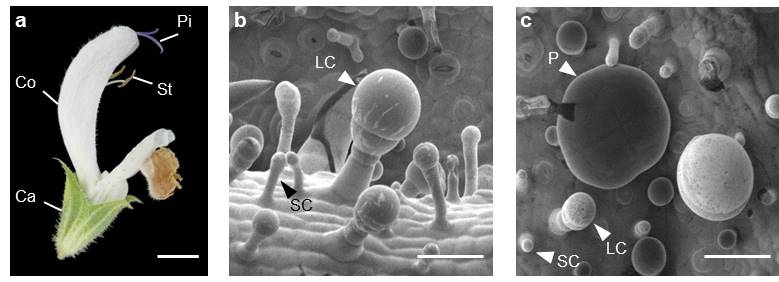Glandular trichomes: bioreactors for the production of specialized metabolites
Sclareol, a specialized antifungal metabolite produced by clary sage, Salvia sclarea, is the natural plant starting molecule used for the hemisynthesis of ambroxide, an ingredient used in fine perfumery. Sclareol is mainly produced in the calyxes of clary sage flowers; however, the cellular location of sclareol biosynthesis remains unknown.
In order to elucidate the site of sclareol biosynthesis, the Flower and Carpel Development team from IPS2, in collaboration with the Molecular Chemistry Laboratory (LCM, UMR 9168, CNRS, Ecole Polytechnique, Institut Polytechnique de Paris) and the Soil, Structures and Materials Mechanics Laboratory, MSSMat (UMR 8579 CNRS/ CentraleSupélec/UPSaclay, Gif-sur-Yvette), analyzed its spatial distribution in the calyx epidermis using laser desorption/ionization mass spectrometry imaging (LDI-FTICR-MSI) and studied the expression profile of sclareol biosynthesis genes in isolated glandular trichomes (GT).
Their study published in Horticulture Research shows that sclareol specifically accumulates in glandular cells of GTs in which sclareol biosynthetic genes are highly expressed. They then isolated a glabrous beardless mutant and demonstrated that more than 90% of the sclareol is produced by the large capitate GTs, a morphological type of GTs with a long stalk topped by a small spherical secretory head (see the figure below). Experiments using the isotopic tracer 13C-glucose and specific enzyme inhibitors also revealed that the methylerythritol phosphate (MEP) biosynthetic pathway was the primary source of the isopentenyl diphosphate (IPP) precursor used for sclareol biosynthesis.
These results demonstrate that sclareol is a MEP-derived diterpene produced by clary sage capitate GTs, highlighting the role of GTs as biofactories dedicated to the production of specialized metabolites.

november 04, 2021
